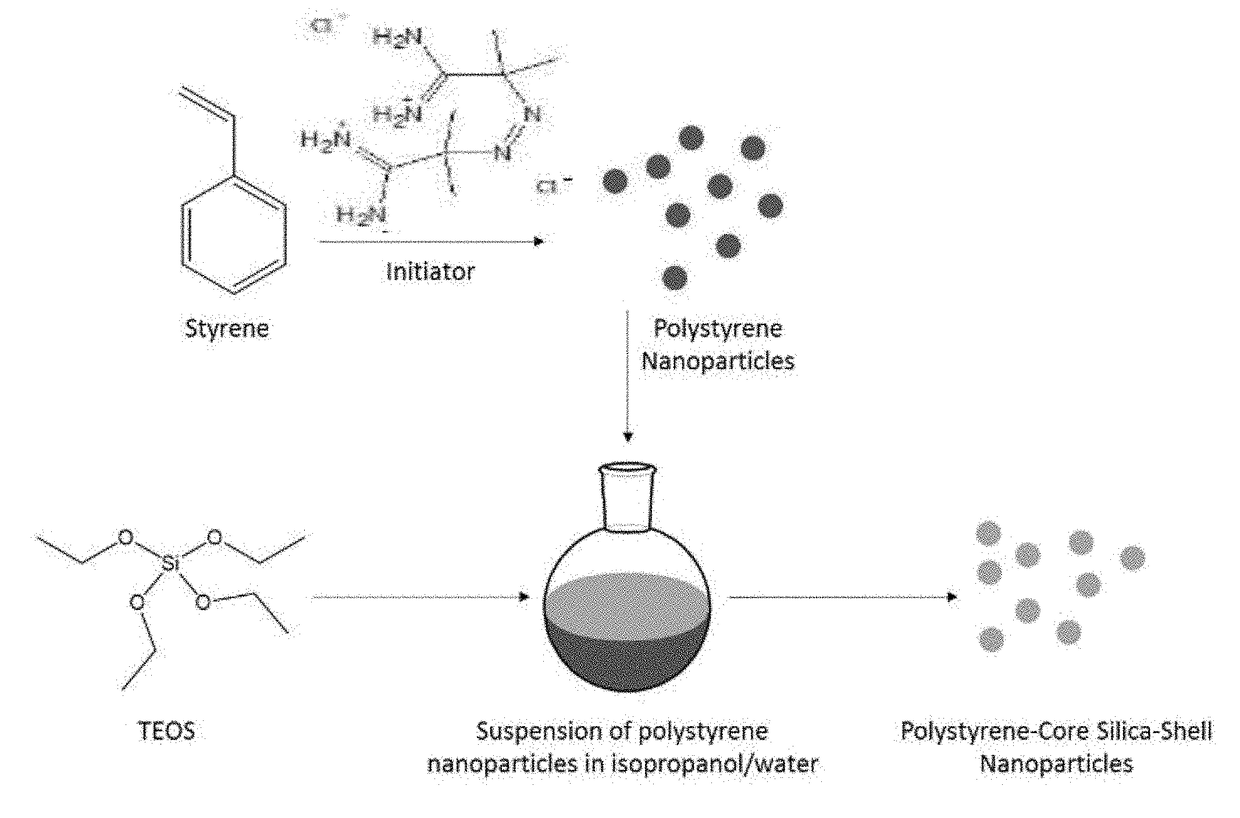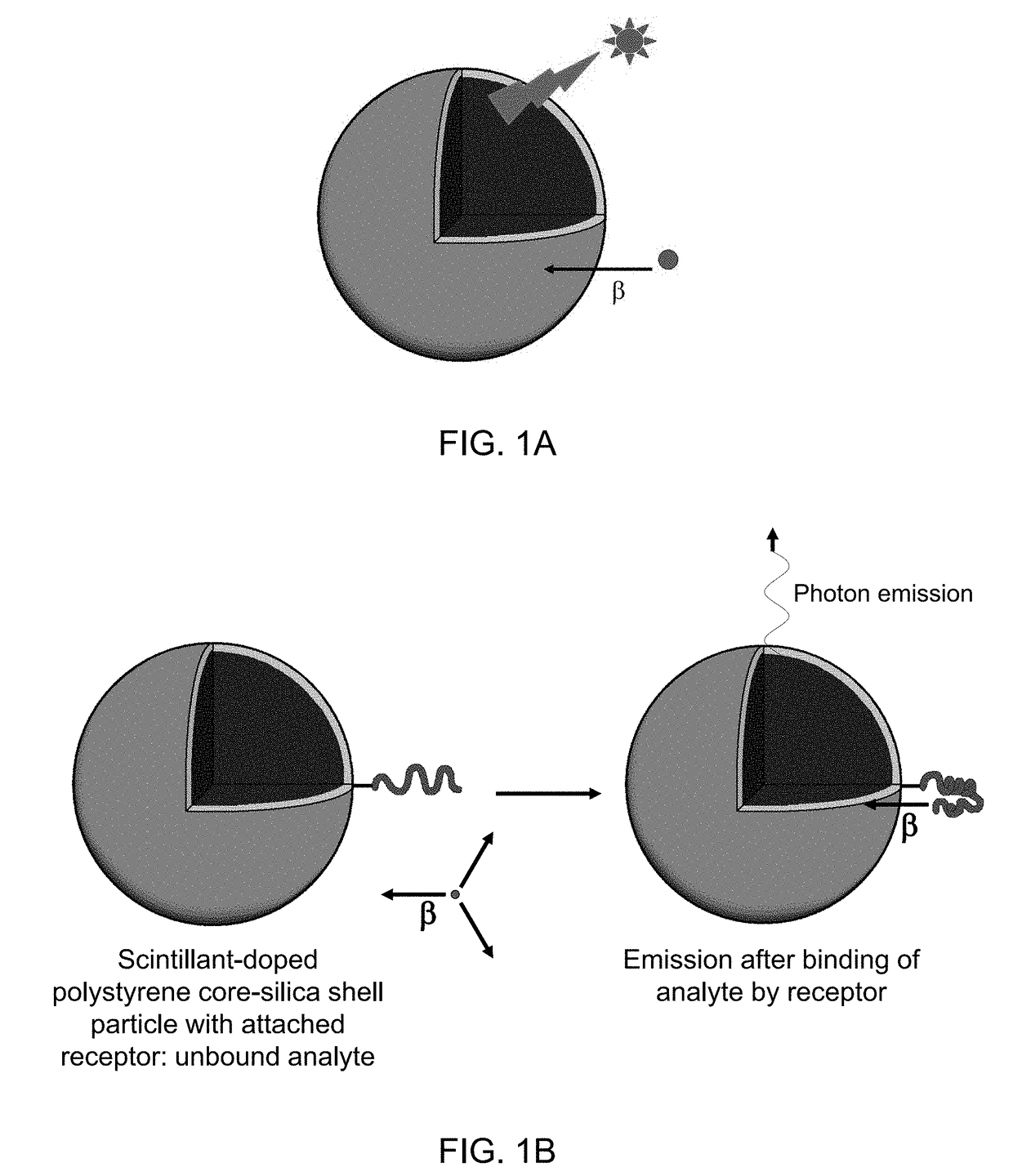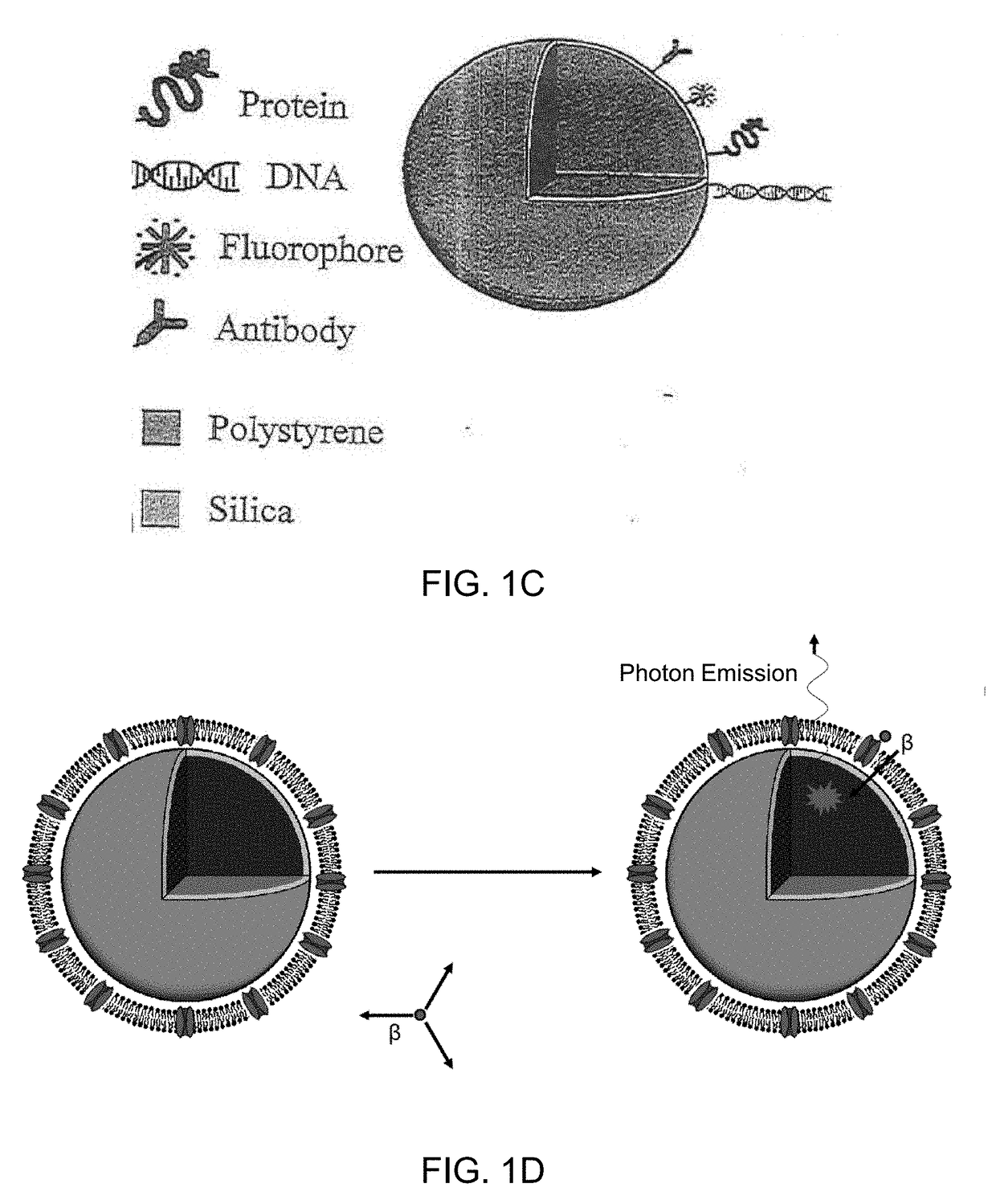Scintillant nanoparticles for detection of radioisotope activity
a radioisotope activity and nanoparticle technology, applied in the field of surface modification, can solve the problems of difficult quantification of radioisotopes, limited use of ex vivo bulk biological samples measurement, toxicity and volatility of primary solvent components of many lsc formulations, complicating their transport, storage, and disposal, etc., to achieve maximum scintillation efficiency, facilitate energy absorption and transfer, and low cost
- Summary
- Abstract
- Description
- Claims
- Application Information
AI Technical Summary
Benefits of technology
Problems solved by technology
Method used
Image
Examples
example 1
[0144]The following is a non-limiting example of producing polystyrene core-silica shell nanoparticles. Equivalents or substitutes are within the scope of the present invention.
[0145]Materials
[0146]The primary scintillant p-terphenyl (pTP) and secondary scintillant 1,4-bis(4-methyl-5-phenyl-2-oxazolyl)benzene (dimethyl-POPOP) were obtained from Acros Organics (Geel, Belgium). Styrene, biotin-N-hydroxysuccinimide (biotin-NHS), 2,2′-azobis (2-methylpropionamidine) dihydrochloride (AAPH), tetraethylorthosilicate (TEOS), and 3-aminopropyltriethoxysilane (APTS) were obtained from Sigma Aldrich (St. Louis, Mo.). 3H acetic acid (500 mCi / mmol) and 3H glutamic acid (49.6 Ci / mmol) were obtained from MP Biomedicals (Solon, Ohio) and Perkin Elmer (Boston, Mass.) respectively. Sodium dodecylsulfate (SDS) was obtained from Fisher (Pittsburgh, Pa.).
[0147]Fabrication of Scintillant-Doped Polystyrene Core nPs
[0148]Scintillant-doped polystyrene (PS) core nPs were fabricated via a surfactant-free emul...
example 2
[0166]The following is a non-limiting example of producing polystyrene-core silica-shell scintillant nanoparticles (nanoSCINT) for low-energy radionuclide quantification in aqueous media. Equivalents or substitutes are within the scope of the present invention.
[0167]Materials
[0168]Styrene, alumina, p-terphenyl (pTP), and 1,4-Bis(4-methyl-5-phenyl-2-oxazolyl)benzene (dimethyl-POPOP) were purchased from Acros Organics. Tetraethylorthosilicate (TEOS), and 2,2′-azobis(2-methylpropionamidine) dihydrochloride (AIBA), Triton X-100,cycloheaxane, sodium citrate (tribasic) hydrate, sodium tetraborate hydrate, and 2-(N-morpholino)ethanesulfonic acid hydrate (MES) were obtained from Sigma Aldrich. Sodium chloride, sodium phosphate hydrate (monobasic), isopropanol and ammonium hydroxide were obtained from EMD Millipore. Hexanol was purchased from Alfa Aesar. BioCount Liquid scintillation cocktail was acquired from Research Products International. 3H labelled acetic acid (as sodium acetate) was p...
example 3
[0186]The following is a non-limiting example of a polystyrene-core silica-shell nanoparticle-based SPA platform (nanoSPA). Equivalents or substitutes are within the scope of the present invention.
[0187]In a preferred embodiment, a core-shell nanoparticle based scintillation proximity assay platform for the detection of 3H labeled analytes features scintillant fluorophores incorporated into polystyrene core particles surrounded by functionalized silica shells. The functional groups of the silica shells then allow for the covalent attachment of specific binding moieties such as proteins, small molecules, or DNA. The utility of the SPA platform has been demonstrated in two model assays, one in which biotin-functionalized nanoSPA particles are used to measure 3H-labeled Neutravidin, and another in which DNA-oligomer-functionalized nanoSPA particles are used to detect a 3H-labeled complementary strand via hybridization. In both models, nanomole and sub-nanomole amounts of the targets we...
PUM
| Property | Measurement | Unit |
|---|---|---|
| penetration depths | aaaaa | aaaaa |
| penetration depths | aaaaa | aaaaa |
| size | aaaaa | aaaaa |
Abstract
Description
Claims
Application Information
 Login to View More
Login to View More - R&D
- Intellectual Property
- Life Sciences
- Materials
- Tech Scout
- Unparalleled Data Quality
- Higher Quality Content
- 60% Fewer Hallucinations
Browse by: Latest US Patents, China's latest patents, Technical Efficacy Thesaurus, Application Domain, Technology Topic, Popular Technical Reports.
© 2025 PatSnap. All rights reserved.Legal|Privacy policy|Modern Slavery Act Transparency Statement|Sitemap|About US| Contact US: help@patsnap.com



